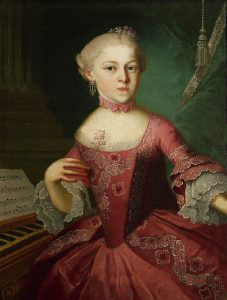From the Archives: Isabella Who?
I recently took a little research detour to find out something about Isabella Jagellion, who has been popping up in my reading for roughly a year now, usually in the form of a one-liner to the effect that she was the first ruler in history to issue an edict of universal religious toleration in 1558--an achievement normally accorded to Henry IV of France, who was responsible for the edict of Nantes in 1589.* I'll let you do the math.
I soon found out that there is more to her story.
Isabella was a Polish princess who was married to the 52-year-old king of Hungary, Janos Zapolyta, in 1539, when she was only 20--a way of cementing an alliance between the two kingdoms in their joint fight against the eastern expansion of the Hapsburg dynasty.** Essentially, her job was to get pregnant as quickly as possible and produce an heir. Zapolya had recently lost a ten-year war with the Hapsburg emperor, Ferdinand I The peace treaty divided Hungary into two parts. Western Hungary became part of the Hapsburg empire. Zapolyta now ruled the eastern part of Hungary as the king of Transylvania. If he died without an heir, Transylvania would revert to Ferdinand.
Isabella did not disappoint. A year after their marriage she gave birth to a son. Two weeks later, Zapolyta died, having lived long enough to see his heir if not to ensure that heir's uncontested succession. The Estates of Transylvania recognized the infant Sigismond aas King of Transylvania and accepted Isabella as queen regent.*** Ferdinand tried to claim Transylvania by occupying Buda. When Ferdinand besieged Isabella at the castle of Olah, the Ottoman emperor, Suleyman the Magnificent, brought a large army to raise the siege. This was like have a hungry dragon save you from the Big Bad Wolf.
For the next five years, Isabella was engaged in an unequal three-way contest with the two empires for control of Transylvania. In 1547, Ferdinand and Suleymana signed a truce and tried to relegate Isabella (and Sigismond--who it's easy to forget) to the territory of Opole, the smallest and least populated province of Poland. Isabella dug in her heels and fought for the rights of her son. In 1556, the Estates of Transylvania once again confirmed Sigismond as their ruler. From 1556 until her death in 1559, Isabella ruled Transylvania as her son's regent. Among other acts designed to bring peace to the kingdom, she issued a law giving religious toleration to all her subjects.
I don't know whether they lived happily, and tolerantly, ever after. But the Hapsburgs did not manage to get control of Transylvania until the eighteenth century.
*In fact, Genghis Khan beat them both to the punch. He not only passed laws of religious toleration three hundred years earlier than either of them, but those laws were far more universal in terms of what religions they covered. Both Isabella and Henry were interested in toleration within Christianity. Genghis Khan extended religious toleration to all religions within his empire. Except Daoism. Every emperor has his blind spots.
**Unlike their counterparts in fairy tales or Disney movies, very few historical princesses got to marry a young and handsome prince. One of the few exceptions was another Isabella, Isabella of Castile. While her brother was hawking her around the marriage markets of fifteenth century Europe, she secretly negotiated her marriage to Ferdinand of Aragon. It was the first step in a lifetime of power plays.
***Widowed queens or noblewoman were often chosen as regents for underaged sons, on the not-always-accurate presumption that mother-love (or laws that prevented them from inheriting) would make them safer choices than a power hungry uncle or maternal grandfather. Which is not to say than an occasional queen regent didn't hang onto power long past her sell-by date.
From the Archives: The Weeping Widow
The world's first female prime minister, Sirimavo Bandaranaike of what was then Ceylon, is the archetypical example of what political scientists sometimes refer to as the "widow's walk to power,” in which a woman steps into a position of political power after the often-violent death of her husband.The assumption is such women will carry on the same policies and protect the same interests as the men whose size elevens they try to fill.
Her husband, S.W.D. Bandaranaike, was a national hero who democratized Ceylon's government after it gained independence from Great Britain in 1956. A Buddhist monk assassinated him three years after he was elected; his death left a power vacuum not only in the Ceylonese government but in the political party that he founded. After several months of bitter infighting, several key party members asked Bandaranaike to run for office in his place, assuming she would be a political placeholder.
Bandaranaiake was the visual embodiment of what her society expected from a widow, from the dark shadows under her eyes to her white mourning sari. She played tapes of her husband’s speeches at every campaign stop. The press called her the “weeping widow.”
In fact, Bandaranaiake was not the political innocent expected by both her supporters and detractors. In addition to the political education she received as the daughter and wife of important politicians, she had years of experience as an leader in Ceylon’s largest Buddhist women’s organization. Prior to her first election, she worked to improve economic and social conditions in rural areas, focusing on rice yields, women’s education, and access to family planning—all political hot buttons at the time.
Her widow's walk was the first step in a forty-year career in national politics. She served as prime minister three times for a total of eighteen years and became a dominant figure in Sri Lankan politics. A weeping widow, perhaps, but not a wimpy widow.
Road Trip Through History: Salzburg, Pt. 3, The Other Mozart
Wolfgang Amadeus Mozart is impossible to avoid if you spend any time in Salzburg. A dedicated tourist could attend a Mozart concert everyday of the week without much effort. The city has transformed both his birthplace and the building where his family rented an apartment from 1773-1787 (1) into museums. (2) At least one tour company runs a bus tour that follows “in the footsteps of Mozart.” His picture is prominently displayed in the many, many shops that sell the ubiquitous Mozartkugel (3) and his name is attached to a number of restaurants and hotels throughout the city.
I am fond of Mozart’s music, but I came away fascinated by another Mozart, his older sister Maria Anna Walburga Ignatia Mozart (1751-1829), nicknamed "Nannerl”, who was a musical prodigy in her own right.
I had been vaguely aware of Ms. Mozart before,(4) but her story clicked into focus for me in an exhibit at the Salzburg Museum devoted to historical musical instruments. The exhibit is fascinating. Instruments from the museum’s extensive collection are not only displayed and placed in context, but recordings allow you to hear them played by professional musicians. Some are familiar, like lutes, harpsichords and French horns. Others are not: the theorbo and the pommel for instance. Personally I was fascinated by the pochette,(5) also known as the dance-master’s violin, and the steel piano, also known as steel laughter.
One of the first pieces in the exhibit was Ms. Mozart’s clavichord, and a brief description of her life. She was five years older than her famous brother, and had already proven herself a talented musician at the time that he wrote his first composition. In fact, the two toured together for three years when they were children. She sometimes received top billing and a review from that period praised her in terms not that different from those showered on her younger brother:
Imagine an eleven-year-old girl, performing the most difficult sonatas and concertos of the greatest composers, on the harpsichord or fortepiano, with precision, with incredible lightness, with impeccable taste. It was a source of wonder to many.
But actions that were acceptable for a little girl were not acceptable for a grown woman. When Ms. Mozart was eighteen, her days on the concert trail were over. She was left behind in Salzburg when her father took her brother back on the road. She eventually married an older man chosen by her father, Johann Baptist Berchtold zu Sonnenburg. After his death, she returned to Salzburg, where she taught music.
There is evidence that she composed in addition to playing. Surviving letters (6) suggest that her brother consulted with her about musical issues. But unless new material comes to light, we’ll never know what her compositions sounded like because none of them have survived.
Maria Anna Mozart’s ambiguous place in musical history—not entirely forgotten but thoroughly overshadowed—can be summed up in her entry in the Encyclopedia Britannica: “Maria Anna Mozart, Austrian pianist. [So far, so good] Britannica does not currently have an article on this topic.” Get on it, people.
(1) Which doesn’t sound like a long time until you remember that he died at the age of 35.
(2) We visited the so-called Mozart Residence. I wouldn’t recommend it unless you are a Mozart groupie. There really isn’t much to see: the fact that one of the eight rooms is devoted to the musical career of his son who, by the museum’s own account, wasn’t anything special as a musician or composer tells you all you need to know. Much of the audio tour is snippets of Mozart’s music, which is pleasant but there are plenty of places to hear Mozart while you are in Salzburg. The best part of the museum was the final room, which talked about the use of Mozart’s image as a marketing device and included a life-size cardboard silhouette of the composer. At 5 foot and almost 2 inches, I would have towered over him.
(3) The candy—a ball of pistachio marzipan coated with a layer of nougat covered with a layer of chocolate—was created by a Salzburg confectioner in 1890. It seemed like a must try for a Salzburg visit. My take? *Meh* (Of course, I felt the same way about the Sacher torte we ordered at the Sacher hotel. I may not be the right audience for Austrian sweets.)
(4) Somehow calling her “Nannerl”, as so many scholars do, feels disrespectful and simply calling her Mozart will lead to confusion.
(5) French for pocket, because the instrument was theoretically designed to fit in a pocket. Though not in any pocket I’ve ever had.
(6) Of which there are many, thanks to Ms. Mozart herself, who served as the family’s unofficial archivist



